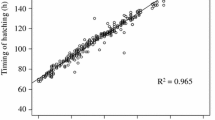Abstract
At least 19 hypotheses have been proposed to explain the evolutionary significance of avian hatching asynchrony, and hatching patterns have been suggested to be the result of several simultaneous selective pressures. Hatching asynchrony was experimentally modified in the black kite Milvus migrans by manipulating the onset of incubation during the laying period. Delayed onset of incubation reduced egg viability of first-laid eggs, especially when ambient temperature during the laying period was high. Brood reduction (nestling mortality by starvation or siblicide) was more commonly observed in asynchronous nests. The growth rate was slower in synchronous broods, probably due to stronger sibling rivalry in broods with high size symmetry. Last-hatched chicks in synchronous broods fledged at a small size/mass, while in control broods, hatching order affected growth rates, but not final size. Brood reduction, variable growth rates, and the ability to face long periods of food scarcity are probably mechanisms to adjust productivity to stochastic food availability in a highly opportunistic predator. The natural pattern of hatching asynchrony may be the consequence of opposing selective forces. Extreme hatching synchrony is associated with slow growth rates, small final size of last-hatched chicks, and low viability of first-laid eggs, while extreme hatching asynchrony is associated with high mortality rates. Females seem to facultatively manipulate the degree of hatching asynchrony according to those pressures, because hatching asynchrony of control clutches was positively correlated with temperature during laying, and negatively correlated with the rate of rabbit consumption.
Similar content being viewed by others
Author information
Authors and Affiliations
Additional information
Received: 25 October 1999 / Revised: 30 May 2000 / Accepted: 25 June 2000
Rights and permissions
About this article
Cite this article
Viñuela, J. Opposing selective pressures on hatching asynchrony: egg viability, brood reduction, and nestling growth. Behav Ecol Sociobiol 48, 333–343 (2000). https://doi.org/10.1007/s002650000245
Issue Date:
DOI: https://doi.org/10.1007/s002650000245




